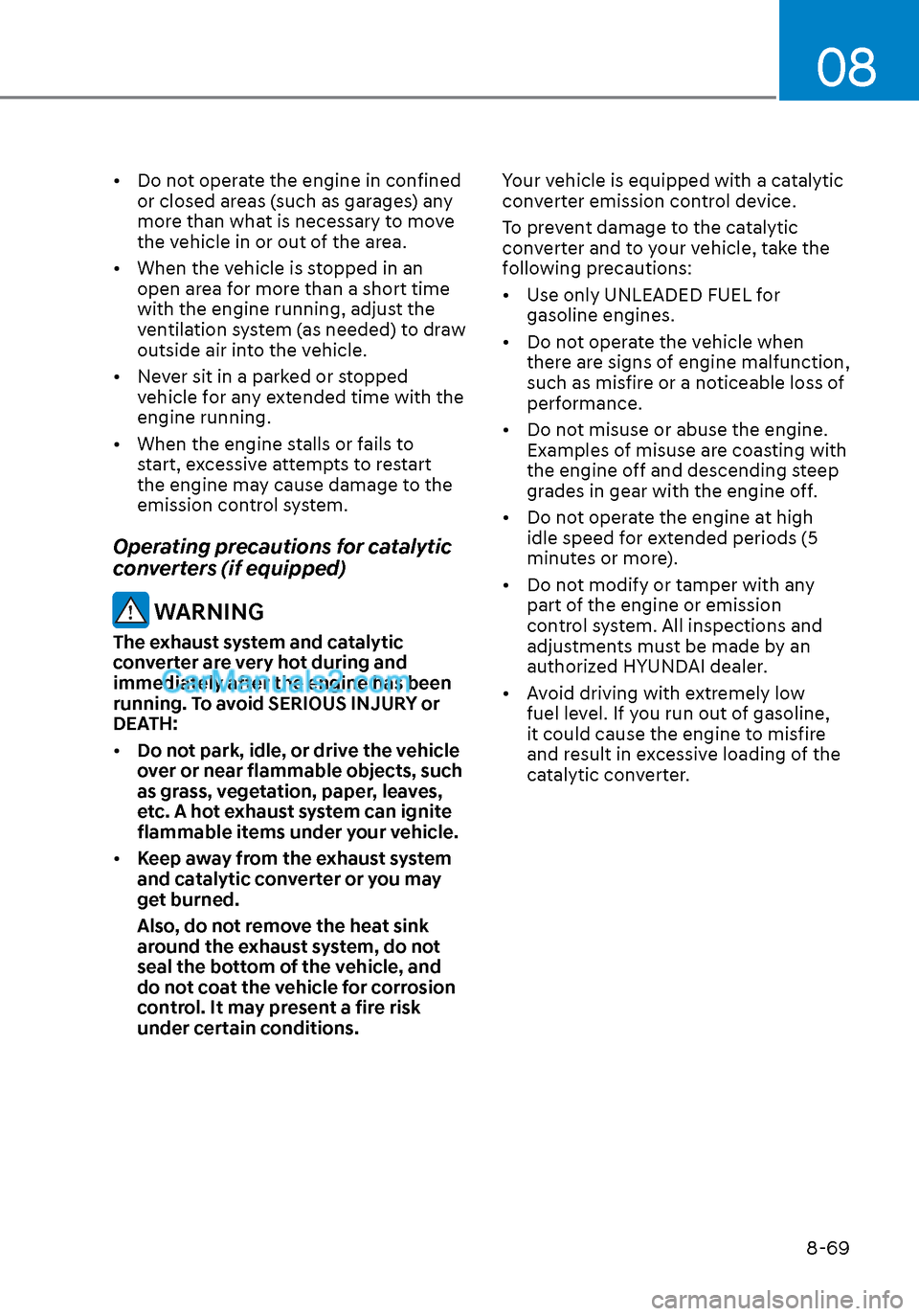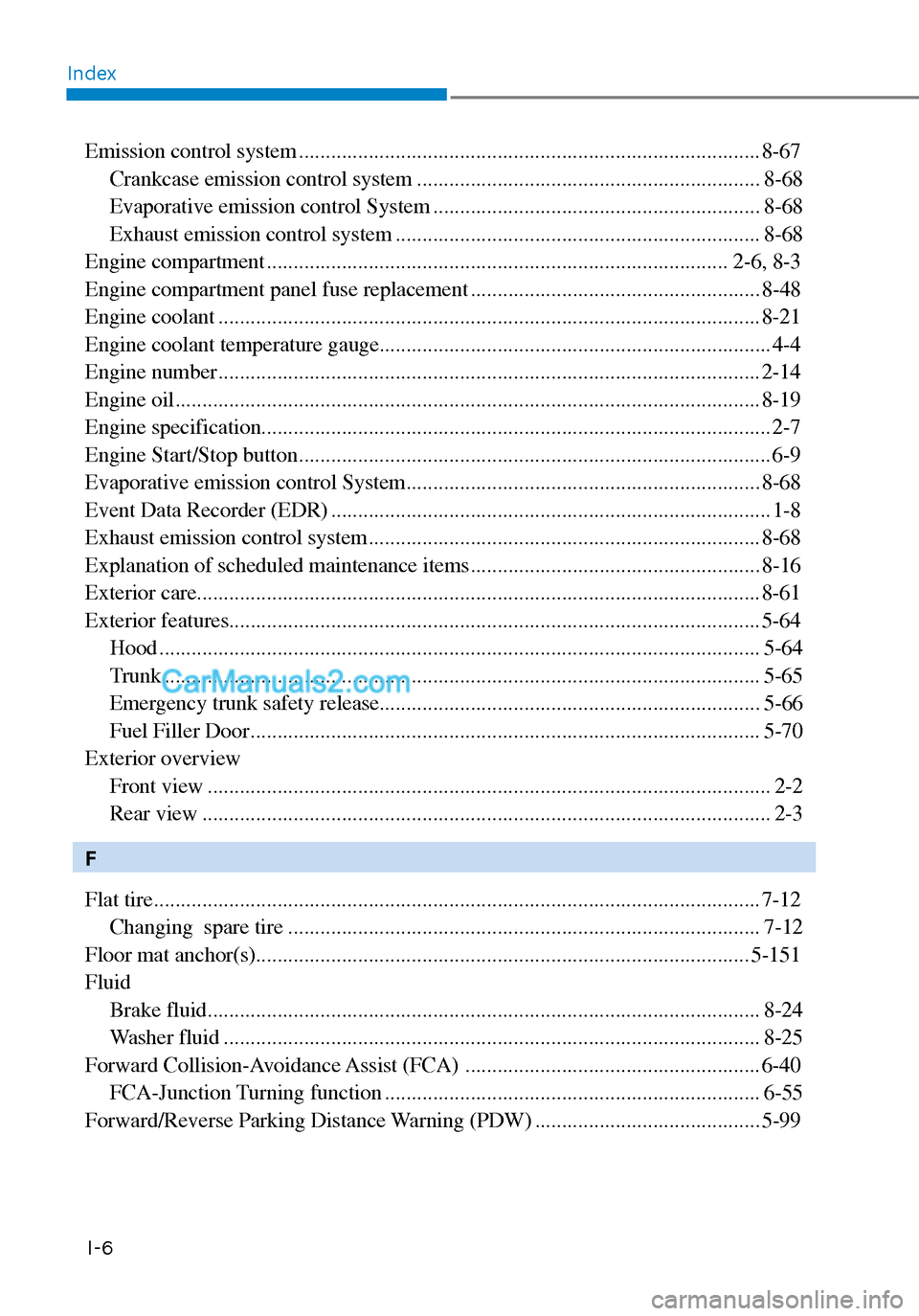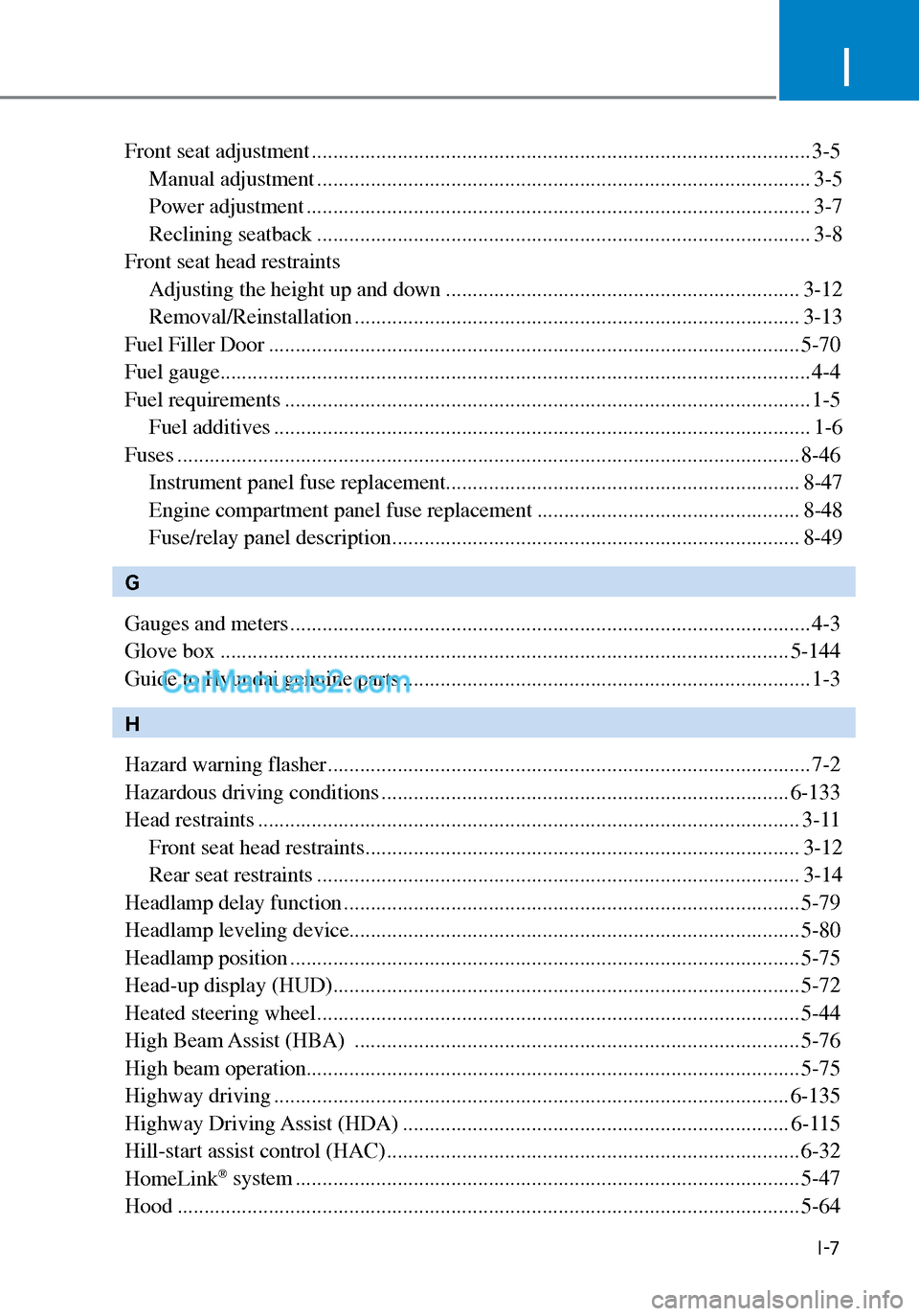2020 Hyundai Sonata engine
[x] Cancel search: enginePage 500 of 537

08
8-53
Engine compartment fuse panel
Fuse Name (A)Circuit Protected
MULTI
FUSE
-1 IG2 30A E/R Junction Block (Start Relay), PCB Block (IG2 Relay)
BLOWER 40A E/R Junction Block (Blower Relay) ABS1 40A ESC ModuleB+2 50A ICU Junction Block (IPS4, IPS3, IPS1, Fuse - AMP, IBU1)
PTC HEATER 50A E/R Junction Block (PTC Heater Relay) B+3 50A ICU Junction Block (IPS5, IPS7, IPS9, IPS10, IPS8, IPS6)
OIL PUMP1 50A Electronic Oil Pump COOLING FAN 80A Cooling Fan Motor
MDPS 80A MDPS Unit
MULTI
FUSE-2 E-SHIFTER 30A SCU
E-CVVT1 40A [G4FN] CVVD ACTUATOR
[====] E/R Junction Block (E-CVVT Relay)
IG1 40A PCB Block (IG1 Relay, ACC Relay)
REAR
HEATED 50A E/R Junction Block (Rear Heated Relay)
EPB 60A ESC Module B+5 60A PCB Block (Engine Control Relay, Fuse - A/C1,
WIPER1, TCU1, HORN, ECU2)
B+1 60A ICU Junction Block (Fuse - P/SEAT (DRV),
P/SEAT (PASS), MODULE1, SAFETY P/WINDOW (LH),
SAFETY P/WINDOW (RH), S/HEATER (RR))
Page 501 of 537
![Hyundai Sonata 2020 Owners Manual Maintenance8-54
Engine compartment fuse panel
Fuse Name (A) Circuit Protected
FUSE HEA
TED
MIRROR 10ADriver/Passenger Power Outside Mirror, A/C Switch,
A/C Control Module, ECM
ECU5 10A [G4FN] ECM
A Hyundai Sonata 2020 Owners Manual Maintenance8-54
Engine compartment fuse panel
Fuse Name (A) Circuit Protected
FUSE HEA
TED
MIRROR 10ADriver/Passenger Power Outside Mirror, A/C Switch,
A/C Control Module, ECM
ECU5 10A [G4FN] ECM
A](/manual-img/35/16773/w960_16773-500.png)
Maintenance8-54
Engine compartment fuse panel
Fuse Name (A) Circuit Protected
FUSE HEA
TED
MIRROR 10ADriver/Passenger Power Outside Mirror, A/C Switch,
A/C Control Module, ECM
ECU5 10A [G4FN] ECM
AMS 10A Battery Sensor
FUEL PUMP 1 20A E/R Junction Block (Fuel Pump Relay) A/C 2 10A A/C Control Module
B+4 60A ICU Junction Block (Long Term Load Latch Relay,
Fuse - MODULE3, AIR BAG2, E-SHIFTER1, SUNROOF1,
SUNROOF2, S/HEATER (FRT), TRUNK, BRAKE SWITCH,
DOOR LOCK)
Page 509 of 537

Maintenance8-62
ODN8A089039ODN8A089039
NOTICE
• Water washing in the engine
compartment including high
pressure water washing may cause
the failure of electrical circuits
located in the engine compartment.
• Never allow water or other liquids
to come in contact with electrical/
electronic components inside the
vehicle as this may damage them.
NOTICE
Matte paint finish vehicle (if equipped)
Automatic car wash which uses rotating
brushes should not be used as this can
damage the surface of your vehicle. A
steam cleaner which washes the vehicle
surface at high temperature may cause
oil to adhere and leave stains that is
difficult to remove.
Use a soft cloth (e.g. microfiber towel
or sponge) when washing your vehicle
and dry with a microfiber towel. When
you hand wash your vehicle, you should
not use a cleaner that finishes with wax.
If the vehicle surface is too dirty (sand,
dirt, dust, contaminant, etc.), clean the
surface with water before washing the
car.
Waxing
A good coat of wax provides a barrier
be
tween your paint and environmental
contamination.
Keeping a good coat of wax on your
vehicle will help protect it.
Wax the vehicle when water will no
longer bead on the paint.
Always wash and dry the vehicle before
waxing. Use a good quality liquid or
paste wax, and follow the manufacturer’s
instructions. Wax all metal trim to protect
it and to maintain its luster.
Removing oil, tar, and similar materials
with a spot remover will usually strip the
wax from the finish. Be sure to re-wax
these areas even if the rest of the vehicle
does not yet need waxing.
NOTICE
• Wiping dust or dirt off the body with
a dry cloth will scratch the finish.
• Do not use steel wool, abrasive
cleaners, or strong detergents
containing highly alkaline or
caustic agents on chrome-plated or
anodized aluminum parts. This may
result in damage to the protective
coating and cause discoloration or
paint deterioration.
NOTICE
Matte paint finish vehicle (if equipped)
Do not use any polish protector such as
a detergent, an abrasive and a polish.
In case wax is applied, remove the wax
immediately using a silicon remover
and if any tar or tar contaminant is on
the surface use a tar remover to clean.
However, be careful not to apply too
much pressure on the painted area.
Page 515 of 537

Maintenance8-68
1. Crankcase Emission Control System
The positive crankcase ventilation system
is employed to prevent air pollution
caused by blow-by gases being emitted
from the crankcase. This system supplies
fresh filtered air to the crankcase through
the air intake hose. Inside the crankcase,
the fresh air mixes with blow-by gases,
which then pass through the PCV valve
into the induction system.
2. Evaporative Emission Control System Including Onboard
Refueling Vapor Recovery
(ORVR)
The Evaporative Emission Control System
is designed to prevent fuel vapors from
escaping into the atmosphere. The
ORVR system is designed to allow the
vapors from the fuel tank to be loaded
into a canister while refueling at the gas
station, preventing the escape of fuel
vapors into the atmosphere.
Canister
Fuel vapors generated inside the fuel
tank are absorbed and stored in the
onboard canister. When the engine is
running, the fuel vapors absorbed in the
canister are drawn into the surge tank
through the purge control solenoid valve.
Purge Control Solenoid Valve (PCSV)
The purge control solenoid valve
is controlled by the Engine Control
Module (ECM); when the engine coolant
temperature is low during idling, the
PCSV closes so that evaporated fuel
is not taken into the engine. After the
engine warms-up during ordinary
driving, the PCSV opens to introduce
evaporated fuel to the engine.
3. Exhaust Emission Control System
The Exhaust Emission Control System is
a highly effective system which controls
exhaust emissions while maintaining
good vehicle performance.
When the engine starts or fails to start,
excessive attempts to restart the engine
may cause damage to the emission
system.
Engine exhaust (carbon monoxide)
precautions
• Carbon monoxide can be present
with other exhaust fumes. If you smell
exhaust fumes of any kind in your
vehicle, drive with all the windows
fully open. Have your vehicle checked
and repaired immediately.
WARNING
Engine exhaust gases contain carbon
monoxide (CO). Though colorless and
odorless, it is dangerous and could be
lethal if inhaled. Follow the instructions
on this page to avoid CO poisoning.
WARNING
CALIFORNIA PROPOSITION 65
WARNING
Engine exhaust and a wide variety of
automobile components and parts,
including components found in the
interior furnishings in a vehicle, contain
or emit chemicals known to the State
of California to cause cancer and
birth defects and reproductive harm.
In addition, certain fluids contained
in vehicles and certain products of
component wear contain or emit
chemicals known to the State of
California to cause cancer and birth
defects or other reproductive harm.
Page 516 of 537

08
8-69
• Do not operate the engine in confined or closed areas (such as garages) any
more than what is necessary to move
the vehicle in or out of the area.
• When the vehicle is stopped in an open area for more than a short time
with the engine running, adjust the
ventilation system (as needed) to draw
outside air into the vehicle.
• Never sit in a parked or stopped vehicle for any extended time with the
engine running.
• When the engine stalls or fails to start, excessive attempts to restart
the engine may cause damage to the
emission control system.
Operating precautions for catalytic
converters (if equipped)
WARNING
The exhaust system and catalytic
converter are very hot during and
immediately after the engine has been
running. To avoid SERIOUS INJURY or
DEATH:
• Do not park, idle, or drive the vehicle
over or near flammable objects, such
as grass, vegetation, paper, leaves,
etc. A hot exhaust system can ignite
flammable items under your vehicle.
• Keep away from the exhaust system
and catalytic converter or you may
get burned.
Also, do not remove the heat sink
around the exhaust system, do not
seal the bottom of the vehicle, and
do not coat the vehicle for corrosion
control. It may present a fire risk
under certain conditions. Your vehicle is equipped with a catalytic
converter emission control device.
To prevent damage to the catalytic
converter and to your vehicle, take the
following precautions:
• Use only UNLEADED FUEL for
gasoline engines.
• Do not operate the vehicle when there are signs of engine malfunction,
such as misfire or a noticeable loss of
performance.
• Do not misuse or abuse the engine. Examples of misuse are coasting with
the engine off and descending steep
grades in gear with the engine off.
• Do not operate the engine at high idle speed for extended periods (5
minutes or more).
• Do not modify or tamper with any part of the engine or emission
control system. All inspections and
adjustments must be made by an
authorized HYUNDAI dealer.
• Avoid driving with extremely low fuel level. If you run out of gasoline,
it could cause the engine to misfire
and result in excessive loading of the
catalytic converter.
Page 525 of 537

IndexI-6
Emission control system ........................................................................\
.............. 8-67 Crankcase emission control system ................................................................ 8-68
Evaporative emission control System ............................................................. 8-68
Exhaust emission control system .................................................................... 8-68
Engine compartment ........................................................................\
.............. 2-6, 8-3
Engine compartment panel fuse replacement ...................................................... 8-48
Engine coolant ........................................................................\
............................. 8-21
Engine coolant temperature gauge........................................................................\
. 4-4
Engine number ........................................................................\
............................. 2-14
Engine oil ........................................................................\
..................................... 8-19
Engine specification........................................................................\
....................... 2-7
Engine Start/Stop button ........................................................................\
................ 6-9
Evaporative emission control System .................................................................. 8-68
Event Data Recorder (EDR) ........................................................................\
.......... 1-8
Exhaust emission control system ........................................................................\
. 8-68
Explanation of scheduled maintenance items ...................................................... 8-16
Exterior care........................................................................\
................................. 8-61
Exterior features........................................................................\
........................... 5-64 Hood ...................................................................\
............................................. 5-64
Trunk ...................................................................\
............................................ 5-65
Emergency trunk safety release....................................................................... 5-66
Fuel Filler Door ........................................................................\
....................... 5-70
Exterior overview Front view ........................................................................\
................................. 2-2
Rear view ........................................................................\
.................................. 2-3
F
Flat tire ........................................................................\
......................................... 7-12 Changing spare tire ........................................................................\
................ 7-12
Floor mat anchor(s)........................................................................\
.................... 5-151
Fluid Brake fluid ........................................................................\
............................... 8-24
Washer fluid ........................................................................\
............................ 8-25
Forward Collision-Avoidance Assist (FCA) ....................................................... 6-40 FCA-Junction Turning function ...................................................................... 6-55
Forward/Reverse Parking Distance Warning (PDW) .......................................... 5-99
Page 526 of 537

I
I-7
Front seat adjustment ........................................................................\
..................... 3-5Manual adjustment ........................................................................\
.................... 3-5
Power adjustment ........................................................................\
...................... 3-7
Reclining seatback ........................................................................\
.................... 3-8
Front seat head restraints Adjusting the height up and down .................................................................. 3-12
Removal/Reinstallation .................................................\
.................................. 3-13
Fuel Filler Door ........................................................................\
........................... 5-70
Fuel gauge ........................................................................\
...................................... 4-4
Fuel requirements ........................................................................\
.......................... 1-5 Fuel additives ........................................................................\
............................ 1-6
Fuses ..................................................................\
.................................................. 8-46
Instrument panel fuse replacement.......................................\
........................... 8-47
Engine compartment panel fuse replacement ................................................. 8-48
Fuse/relay panel description ........................................................................\
.... 8-49
G
Gauges and meters ........................................................................\
......................... 4-3
Glove box ........................................................................\
.................................. 5-144
Guide to Hyundai genuine parts ........................................................................\
.... 1-3
H
Hazard warning flasher ........................................................................\
.................. 7-2
Hazardous driving conditions ........................................................................\
.... 6-133
Head restraints ........................................................................\
............................. 3-11 Front seat head restraints ........................................................................\
......... 3-12
Rear seat restraints ........................................................................\
.................. 3-14
Headlamp delay function ........................................................................\
............. 5-79
Headlamp leveling device........................................................................\
............ 5-80
Headlamp position ........................................................................\
....................... 5-75
Head-up display (HUD) ........................................................................\
............... 5-72
Heated steering wheel ........................................................................\
.................. 5-44
High Beam Assist (HBA) ........................................................................\
........... 5-76
High beam operation........................................................................\
.................... 5-75
Highway driving ........................................................................\
........................ 6-135
Highway Driving Assist (HDA) ........................................................................\
6-115
Hill-start assist control (HAC) ........................................................................\
..... 6-32
HomeLink
® system ........................................................................\
...................... 5-47
Hood ...................................................................\
................................................. 5-64
Page 527 of 537

IndexI-8
Horn ...................................................................\
.................................................. 5-45
How to use this manual ........................................................................\
................. 1-4
Hyundai digital key........................................................................\
...................... 5-15 Digital key application ........................................................................\
............ 5-15
Digital key (smartphone) NFC function ......................................................... 5-15
Digital key (smartphone)..............................................\
................................... 5-16
Digital key (card key)................................................\
...................................... 5-23
I
If the engine doesn’t turn over or turns over slowly .............................................. 7-3
If the engine overheats ........................................................................\
................... 7-6
If the engine stalls at a crossroad or crossing ........................................................ 7-2
If the engine stalls while driving ........................................................................\
... 7-2
If the engine turns over normally but doesn’t start ................................................ 7-3
If the engine will not start ........................................................................\
.............. 7-3
If you have a flat tire while driving ....................................................................... 7-3
Ignition switch ........................................................................\
............................... 6-6 Key ignition switch ........................................................................\
................... 6-6
Engine Start/Stop button ........................................................................\
........... 6-9
Remote start ........................................................................\
............................ 6-12
Immobilizer system ........................................................................\
..................... 5-14
Improtant safety precautions........................................................................\
.......... 3-2
Always wear your seat belt ........................................................................\
....... 3-2
Restrain all children ........................................................................\
.................. 3-2
Air bag hazards ........................................................................\
......................... 3-2
Driver distraction ........................................................................\
...................... 3-2
Control your speed ........................................................................\
.................... 3-2
Keep your vehicle in safe condition .................................................................. 3-2
In case of emergency while driving ....................................................................... 7-2
Infotainment system........................................................................\
................... 5-152
AUX, USB and iPo
d® port ........................................................................\
..... 5-152
Antenna ................................................................\
......................................... 5-152
Steering wheel audio controls ....................................................................... 5-153
Bluetooth
® Wireless Technology hands-free ................................................. 5-154
Audio / Video / Navigation system ............................................................... 5-154
Blue Link
® center ........................................................................\
.................. 5-154
Inside rearview mirror ........................................................................\
................. 5-46